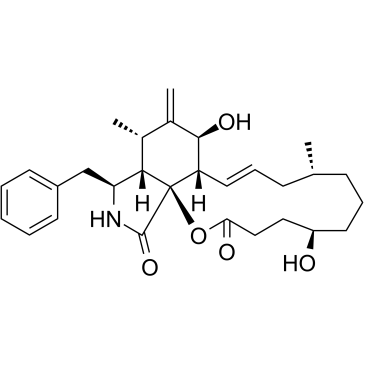The N-formylpeptide receptor (FPR) and a second G(i)-coupled receptor mediate fMet-Leu-Phe-stimulated activation of NADPH oxidase in murine neutrophils.
Mark C Lavigne, Philip M Murphy, Thomas L Leto, Ji-Liang Gao
Index: Cell. Immunol. 218(1-2) , 7-12, (2002)
Full Text: HTML
Abstract
N-Formylypeptides such as fMet-Leu-Phe (fMLF) potently induce superoxide production through NADPH oxidase activation. The receptors that mediate this response have not been defined. Here, we provide definitive proof using a mouse model that formyl peptide receptor (FPR) is a receptor, but not the only receptor, that mediates fMLF-induced oxidase activation. In wild-type (FPR(+/+)) mouse neutrophils, superoxide production is dependent on the concentration of fMLF with an EC(50) of approximately 5 microM and a peak at approximately 50 microM. In contrast, FPR-deficient (FPR(-/-)) mouse neutrophils produced markedly less superoxide with an EC(50) of approximately 50 microM and a peak at approximately 200 microM. Yet, FPR(+/+) and FPR(-/-) neutrophils showed similar oxidase activation kinetics and G(i) protein-dependent pharmacological sensitivities. These results suggested that a second receptor, likely FPR2, mediates superoxide production at high concentrations of fMLF. This less sensitive second pathway may permit continued oxidant generation in response to formyl peptides when FPR is desensitized in high concentrations of the chemotactic gradient.
Related Compounds
| Structure | Name/CAS No. | Molecular Formula | Articles |
|---|---|---|---|
 |
Dihydrocytochalasin B
CAS:39156-67-7 |
C29H39NO5 |
|
Tetraploidization increases sensitivity to Aurora B kinase i...
2012-07-01 [Cell Cycle 11(13) , 2567-77, (2012)] |
|
Centrifugal and chromatographic analyses of tryptophan and t...
2003-02-28 [J. Biochem. Biophys. Methods 55(2) , 127-40, (2003)] |
|
Degradation and recycling of the substrate-binding subunit o...
1996-07-05 [J. Biol. Chem. 271(27) , 16369-74, (1996)] |
|
Complex regulation of human neutrophil activation by actin f...
1997-06-01 [J. Leukoc. Biol. 61(6) , 703-11, (1997)] |
|
Disruption of the actin cytoskeleton leads to inhibition of ...
2000-08-25 [Exp. Cell Res. 259(1) , 35-53, (2000)] |